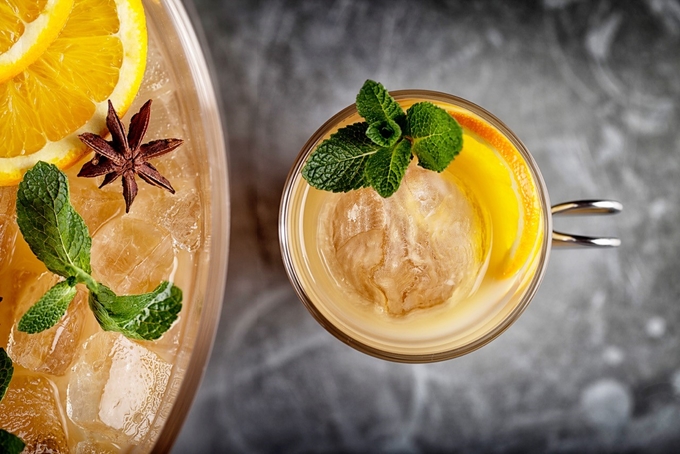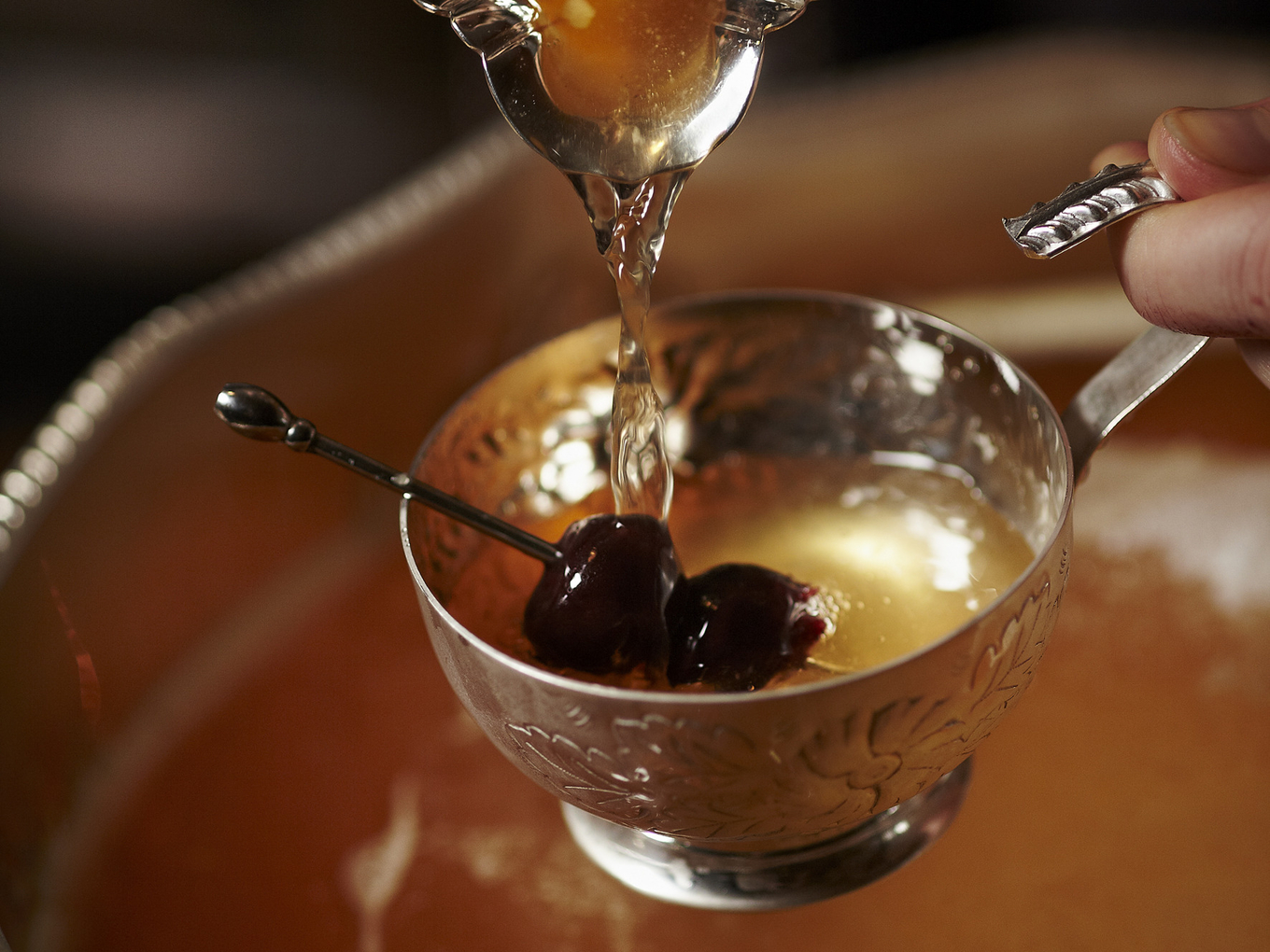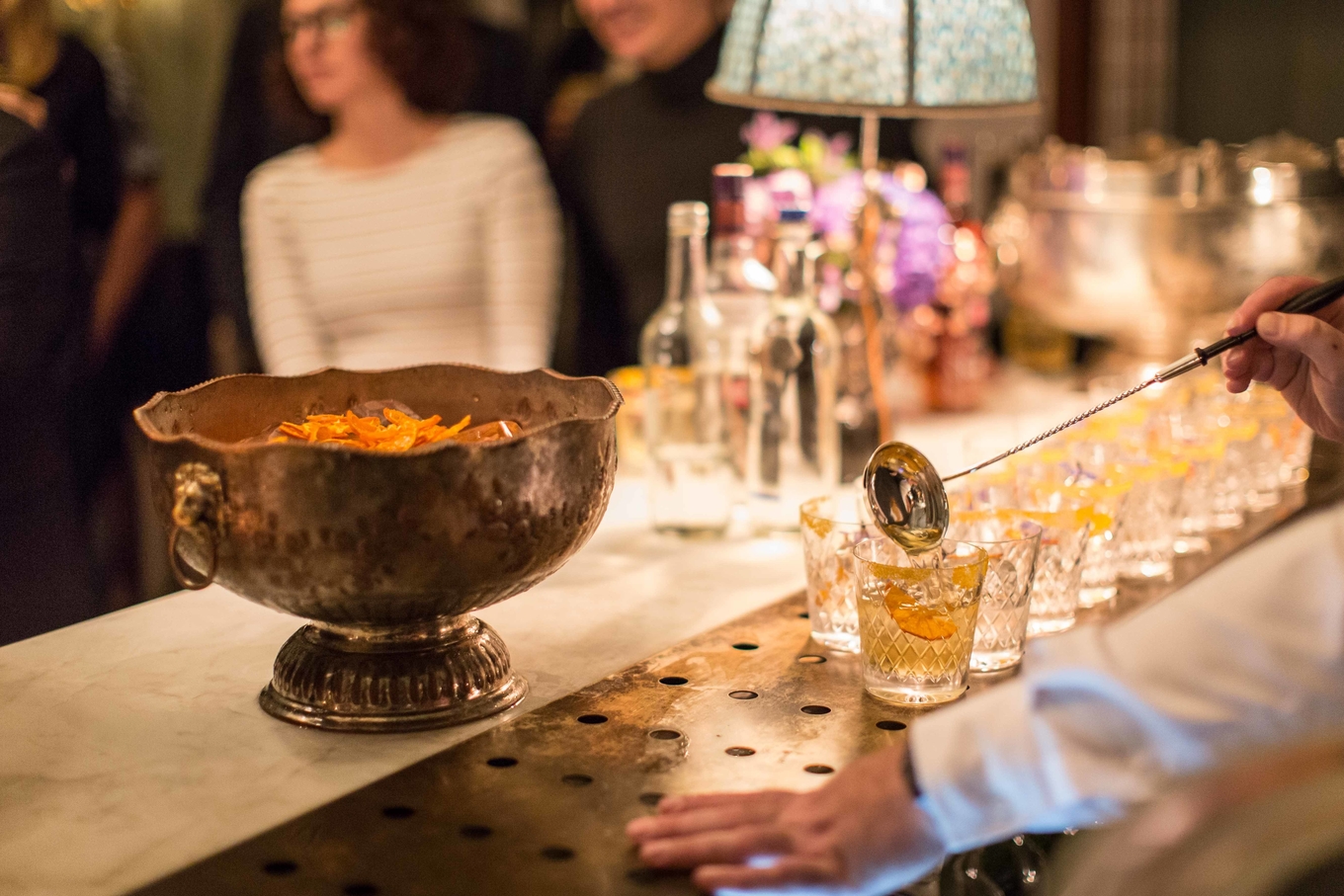Expert tips on how to make and serve punch
Words by Simon Difford
Photography by Alicja Rymarowicz (video)
Consisting of a spirit or spirits (mostly rum), citrus, sugar, water and spice, punch was enjoyed by Charles Dickens, America’s founding fathers, pirates and Royal Navy sailors alike. Punches fell out of favour in the 1800s but are now being rediscovered and embraced by modern day discerning drinkers as the most communal of cocktails.
Banks Rum, one of the spirit brands that has most embraced and helped drive the revival of punch, invited four of what must be the world's foremost punch experts to discuss what makes a well-made punch such a delicious drink. Fittingly we gathered around a bowl of punch in The Lamb & Flag Covent Garden, one of London's oldest taverns and a place where punch would have been served in its heyday, the late 1700s to mid-1800s.
Punch experts
Jillian Vose - Bar Manager at The Dead Rabbit, New York City, a bar where guests are famously served a delicious welcome cup of punch.
David Wondrich - Drinks historian and author of Punch: The Delights (and Dangers) of the Flowing Bowl.
Nick Strangeway - A protégée of Dick Bradsell, in 2006 Nick opened The Hawksmoor steakhouse where he was probably the first to instigate a modern-day punch program.
Davide Segat - Bar Manager of London's award winning The Punch Room since opening 2013, the world's most noted punch bar.
The conviviality of punch
"I love sitting around a bowl of punch with friends because for me a bowl of punch is a project. You know you have it in front of you and everybody knows we're gonna drink this bowl of punch. It's not like if you've got drinks from the bar and everybody gets their own thing. We all know that we've got this and we've got to drink this." So David Wondrich told us as we sat down in front of our bowl of punch. He continued, "That was always the thing about punch; it was always a communal drink."
He's right, you gather round a punch bowl to share. You share the drink, you share tittle tattle, memories and stories. It allows the host to prepare the ingredients hours before and then quickly combine them over a block of ice when guests arrive. That's it, job done. The rest of the night is a shared experience.
At the Dead Rabbit, Jillian says "the big communal punch is something we do for large parties. Punch is also very convenient when we do pop-ups around the world because you can have a wonderful drink with great ingredients but don't have to be so invested in the actual making of it. It's all about the prep and having it ready for when your guests arrive so you can partake in the party instead of being the person that's just making the drinks. Punch is great for parties and for getting people their drinks fast."

Punch as a welcome drink
Many bars serve punch to their guests as a welcome drink to be enjoyed while they peruse the menu. Jillian continues, "we use punch on a daily basis. It's something we like to give our guests when they come in as a little gift. It's a kind of handshake, a trust drink. New guests can see that we know what we're doing and move on to a cocktail. Punch is really great... it's ready, it's delicious, it's pre-diluted, it's cold and it puts the guest at ease."
Nick Strangeway adds, "If somebody looks like they've been waiting for too long, just give them a little taster of punch. It allows you to invite them in to whatever you're doing in your bar at that point. It relaxes them."
Punch recipe
"This ancient Silver bowl of mine, it tells of good old times,
Of joyous days, and jolly nights, and merry Christmas Chimes,
They were a free and jovial race, but honest, brave and true,
That dipped their ladle in the punch when this old bowl was new."
So starts the punch section to Harry Craddock's The Savoy Cocktail Book. Craddock goes on to give this piece of advice "...there is one grand secret in its concoction that must be mastered with patience and care. It is just this, that the various subtle ingredients be thoroughly mixed in such a way, that neither the bitter, the sweet, the spirit, nor any liquor be perceptible the one over the other."
The classic punch proportions are easy to remember due to the rhyme, "one of sour, two of sweet, three of strong and four of weak" - referring to:
One of sour = lime juice or lemon juice
Two of sweet = sugar
Three of strong = arrack, rum or other dark spirit)
Four of weak =Water, fruit juice, cold tea etc.
Spice = nutmeg, cinnamon, rosewater etc
The merits of the punch rhyme are good to chat about around a punch bowl but few of those I know who make lots of punch follow this formula. As David Wondrich says, "For me making punch is like barbequing. It's a thing ... you don't need a recipe; it's a process. You might mix in a little splash of this, a little splash of that but it's instinctual rather than scientific."
"I've been making punch in large quantities and often for about 15 years. I started making all these elaborate Victorian punches where you take each part of the punch and split it up; you divide the spirit element between several spirits - rum, arak, brandy, etc; then you take the water and you use some tea in the water, but the tea also brings spice, and so on. So, you make these lovely complex creations. But the older I get and the more punch I've made, the less I feel the desire to go through all those manipulations because I find that if you have a good spirit, one that's got some character, you don't need much else. I use lemon peel and sugar, water, spirit, maybe a little bit of nutmeg and I find that that's enough. It's so easy, but you need a spirit that's got some terroir to it; that's got individuality. So I'll use something like Banks Rum, I might use a mixture of the Banks 5 and the Banks 7 - Banks 7 for mildness and 5 for a little more extra funk.
"Some punches are great for a few cups but if you're making a big bowl you don't want too much spice in it, in my experience. The older I get, the less spice I want in punch."
Default punch recipe
As David says, "you don't need a recipe; it's a process". However, it's reassuring to have some kind of recipe to at least loosely follow and this recipe which utilises Banks Rum's "funk" is easy to follow and makes for a tasty punch. It is intended for a 4 litre capacity bunch bowl or larger and makes 24 x 90ml servings.
24 hours prior to serving
1. Clean your punch bowl or other suitable container with at least a 4 litre capacity. Locate or buy a suitable punch ladle.
2. Fill a silicon bread mould or other suitable container with water and place in freezer to make a large block of ice that will fit your punch bowl.
3. Peel four unwaxed lemons with as little of the white pith as possible on the peels and place in a one pint Mason/Kilner jar.
4. Use a measuring jug to measure 180 ml of caster sugar and pour into Mason/Kilner jar to cover lemon peels.
5. Seal jar, shake and leave overnight to make your lemon oleo-saccharum.
Immediately prior to serving
6. Add 180ml freshly squeezed lemon juice to the oleo-saccharum in your Mason/Kilner jar. Reseal jar and shake until sugar has dissolved. This turns your oleo-saccharum into a lemon oleo-saccharum shrub. Pour this into punch bowl, peels and all.
7. Pour a 70cl or 75cl bottle of Banks 5 Island Rum into punch bowl
8. Pour 1 litre cold water into punch bowl.
9. Remove your ice block from its mould and slowly slide into your punch and leave to stand in a cool place for 15 minutes.
10. Grate 1/3 of a whole nutmeg over the top of the punch.
11. Use ladle to stir punch and serve your punch.
Whoops, I forgot to make the oleo-saccharum
If you don't have the time to prepare the oleo-saccharum you can skip the above steps 1 to 5 and instead dissolve 180ml Demerara sugar in 90ml water over low heat, stirring until the sugar has dissolved. Leave to cool for 10 minutes before continuing to phase 6, treating your Demerara sugar syrup as if it is oleo-saccharum, but add 180ml lime juice rather than 180ml lemon juice.

Citrus peel
The oil of citrus fruits, particularly lemon peel is very fragrant and crucial to a good punch as it adds an extra dimension to lemon juice. The oils also dry the punch, helping balance sugar and other rich ingredients. To quote Jerry Thomas, "to make punch of any sort in perfection, the ambrosial essence of the lemon must be extracted." The easiest way to extract this oil is with sugar by making oleo-saccharum. Oleo is an essential element of a good punch.
Funk
The first punches were thought to have been made in the early 1600s by merchants working for the British East India Company who found themselves out of supplies of wine and beer in East Asia and South Asia where the locals drank arrack - Batavia arrack in Indonesia and coconut arrack in India. The thing about Batavia arrack in particular is that it has what David Wondrich calls funk.
"The funk that you get in some sugar cane spirits they used to call hogo which was a term from hunting. It was the high taste that meat would develop if you hung it for a while to ripen. That kind of meaty animal funk that you get out of some sugarcane products on its own it can be a little overpowering to say the least, but once you've got it diluted in a punch with the really simple adjuncts of the acid, the sweet and the peel, it gives that little morish something. It's like there's something going on in this punch, I don't know what it is, but I want to taste a little more."
As David says, a little 'funk' is a very desirable thing in a punch and Banks rums have a touch of funk due to having a little Batavia arrack in the blend.
Tea - the English influence
Punch originated in the part of the world where we English started our obsession with tea. Hence, its perhaps not surprising that tea formed part of those early punches and is still an important ingredient today. As Davide Segat says, "classic punch recipes often use tea, black tea or green tea, but now we have hundreds of different teas - hibiscus tea, floral teas, jasmine tea." Why simply add water to a punch when you can add flavoured water - tea.
Dilution
When it comes to your punch and dilution, you've a decision to make. Are you going to start with a perfectly diluted punch and hold that level of dilution by keeping the punch chilled with a means other than by direct contact with ice, or are you going to let your punch evolve?
David Wondrich again, "When you first make the bowl of punch that's going to be shared, it starts off being quite strong and then as the ice dilutes it the punch transforms. There's a sweet spot in the middle, and then, as your guests are getting a little too tipsy, it self-corrects because it gets weaker and weaker, until the end when there's hardly any alcohol in there. They're rehydrating, it's self-correcting, so a punch is lovely for that."
Unless you are making a punch that is going to be consumed almost immediately after it has been served, then cubed ice is not suitable for use in a punch bowl as the ice will melt too quickly and over dilute the punch. Instead, use a block of ice. The bigger the punch bowl so the bigger the block. You can make giant ice-cubes by freezing water in silicon bread moulds.
If you are serving punch to guests as a welcome drink in a bar, then you'll need your punch to be diluted so every guest experiences your punch at its best. That 'sweet spot' is broadly around 16-20% alc./vol., the strength of sherry. To fix that strength/dilution you can simply bottle the punch, store in a refrigerator and then pour as required - remembering to turn the bottle to mix prior to pouring. Or you could copy New York's Dead Rabbit and use a circulator.
Punch on tap
Jillian Vose says "your citrus is going to settle if you simply bottle punch and in some cases your infusion or sugar will also settle so you have to keep the punch moving. At the Dead Rabbit we use a circulator to keep our punch cold and keep everything mixed perfectly. That's how we maintain the punch to be great from the beginning of the day to the end of the day. When finished we completely discard any remaining punch, clean the circulator and then refill it with the next punch and that's something that we do every other day... lemon juice is okay for about 36 hours so that's how we gauge when to refill the circulator with a new punch. Circulators are great but they're not something that we display, they are kind of an eyesore. We have a back area called the pantry where we keep all of our back stock, extra syrups, replacement bottles and the punch circulators."
"Circulators" are more properly termed "chilled drink/juice dispenser with circulation/agitation" and they come in a variety of sizes and styles such as the Grindmaster-Cecilware 20/1PD (available in the USA) and the SucceBuy Juice Dispenser 2 Tanks 36L (available in the UK).

Ladling punch
An attractive and ergonomic punch ladle is as important as the punch bowl itself. As Jillian mentions above, some of the ingredients in a punch will start to settle if left and so when enjoying a punch from a bowl the ladle should be used to gently mix the punch as well as to serve. It's good practice to take a ladle of punch from the bottom of the bowl and pour it over the top of the ice block. (We recommend the Turenne Punch Ladle from Cocktail Kingdom.)
Use what you have available
One of the many benefits of a punch is you can adapt recipes to use ingredients you have to hand. Jillian agrees, "When you do a menu that changes every six months, between times you have some great new products on the market which you're excited about, you have some samples and you say how's this going to work, let's play around and have some fun. Using these ingredients in our welcome punch is a great way to see how guests react and relate to them."
Punch can be an innovative drink
Nick Strangeway, says one of the things he found really interesting was "when I was looking into old recipes I found how innovative punches were. I think cocktails are fairly basic - spirit, ice, a little bit of sugar, bitters, whatever - old cocktail recipes are fairly formulaic. What is interesting about punch is that it allowed individuality to spring up and old punch recipes can be culinary in their approach. For example, the Milk Punch is a very old example of fat-washing. It really struck me that punch doesn't have prescriptive rules. You can be very individual and use culinary techniques in a punch made ahead of service. Punch allows more innovation compared to the cocktail."
The history of punch
Punch is widely considered to be the earliest cocktail - the drink all other cocktails emanate from. To read how it originated and became fashionable see The history of punch.












